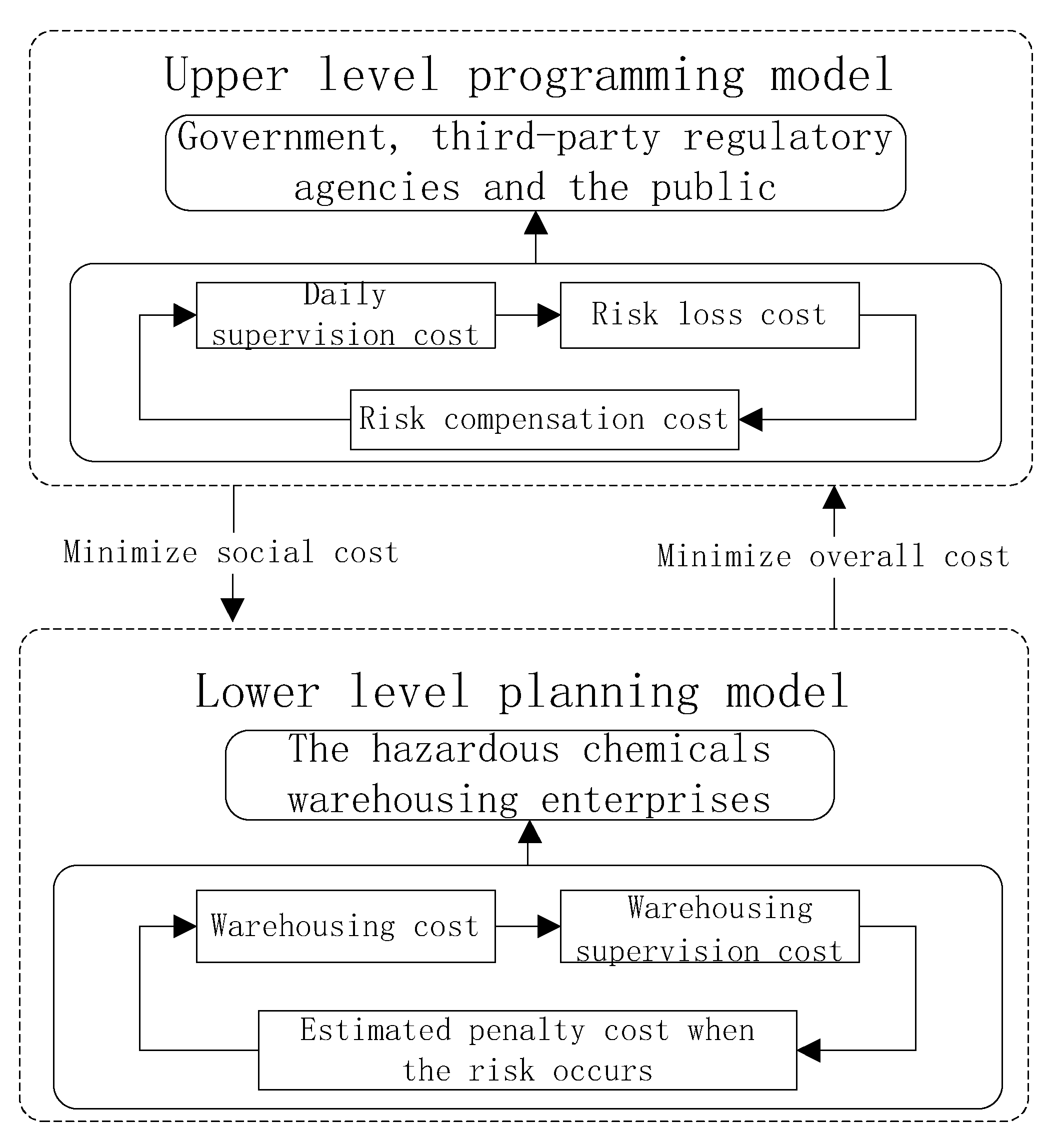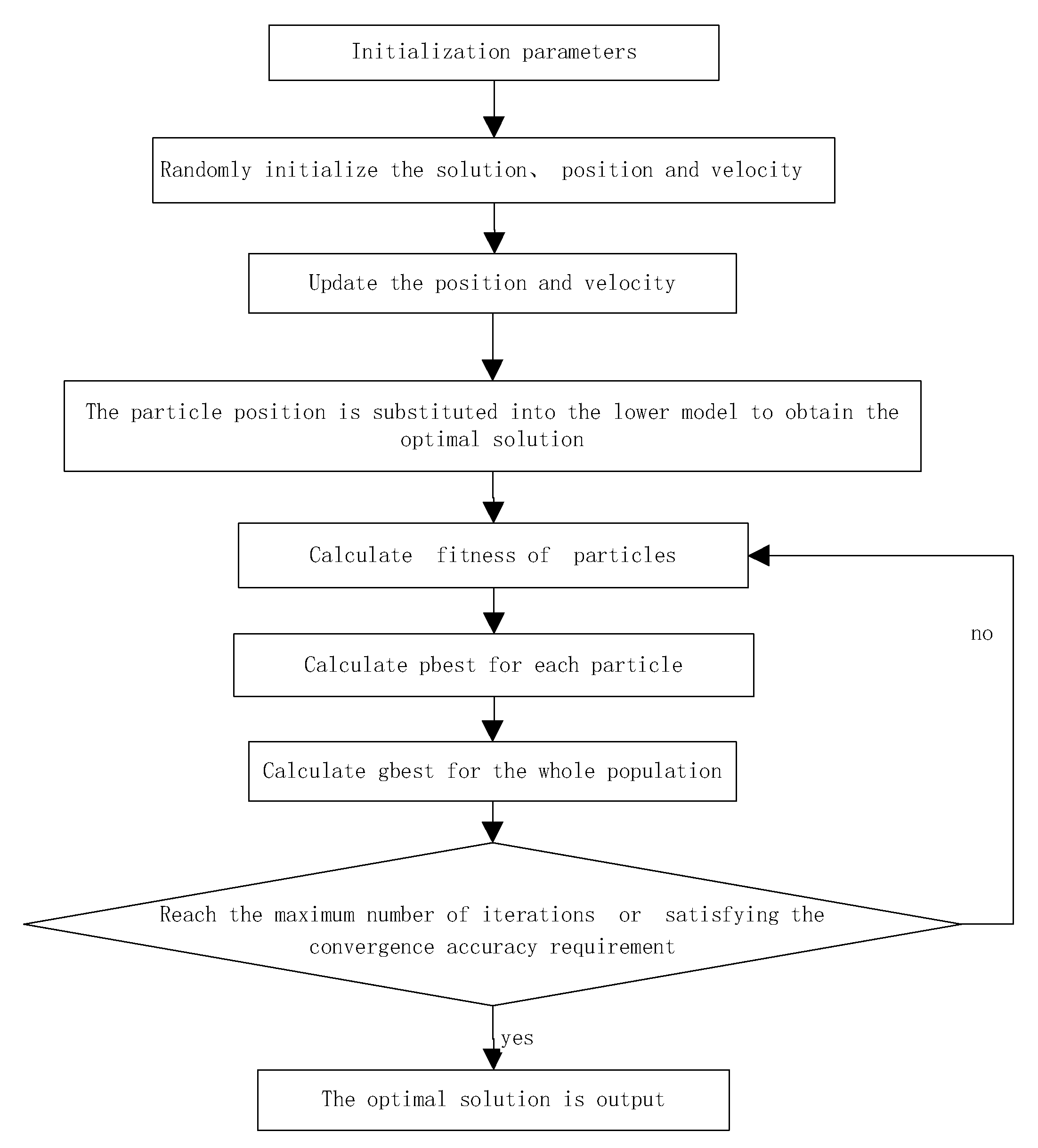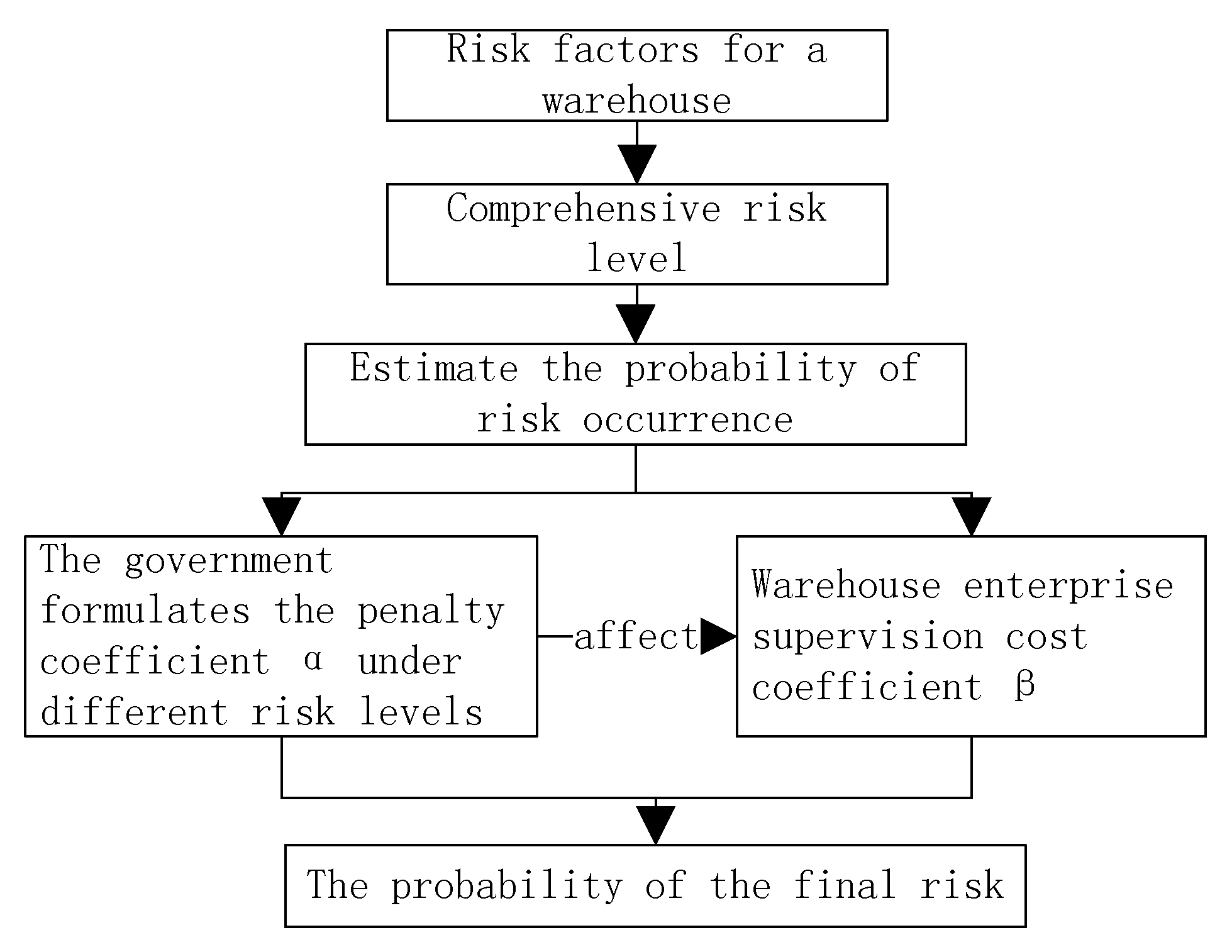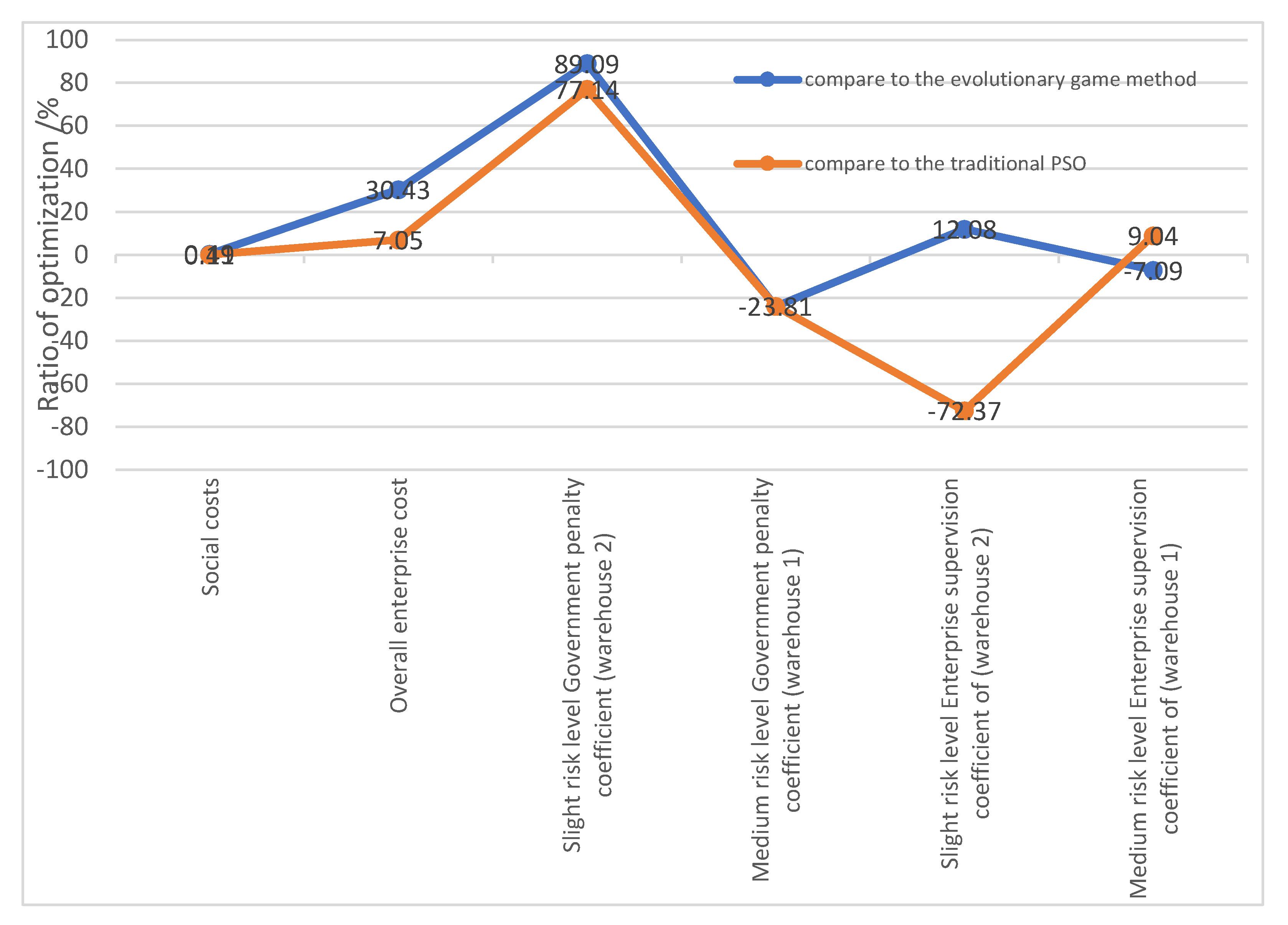Two-Level Programming Model Based on Cooperative Operation Study of Stakeholders in Hazardous Chemical Storage
Abstract
:1. Introduction
- (1)
- This study focuses on the regulatory cooperation among the government, third-party regulatory agencies, the public, and hazardous chemical warehousing enterprises. It also analyzes the interest demands of each stakeholder.
- (2)
- This study proposes a two-level planning economy model to balance the interest demands of all parties as much as possible.
- (3)
- The model in this paper reduces social cost and enterprise cost to the greatest extent.
- (1)
- Firstly, the government in the upper model formulates the relevant penalty coefficient, and the hazardous chemicals warehousing enterprises in the lower model formulates the supervision cost coefficient.
- (2)
- Secondly, the hazardous chemicals warehousing enterprises in the lower-level model determine the comprehensive risk level of goods warehousing status according to relevant standards and estimate the probability of risk occurrence.
- (3)
- Then, the penalty coefficient formulated by the upper-level government will affect the penalty cost of the lower-level enterprises. Through the formulation of the penalty coefficient, the lower-level warehousing enterprises are urged to meet the safety standards in daily supervision.
2. Method and Model
- (1)
- Considering the complexity of enterprise cost, this paper only studies the cost of enterprise storage, so as to replace the overall cost of the enterprise;
- (2)
- The government involved in this paper is the general name of all government departments;
- (3)
- This paper only considers one warehousing enterprise;
- (4)
- In order to simplify the calculation, the classification of people is not considered in risk compensation;
- (5)
- Assume that each costing is based on the unit area of hazardous chemical storage.
2.1. Construction of the Upper Level Model
2.2. Construction of the Lower Level Model
3. Model Solving and Case Analysis
3.1. The Solution Method of Two-Level Programming Model
- (1)
- The disturbance factor is added to the velocity update formula to expand the population search range [25];
- (2)
- The adaptive weight method is used to balance the global search ability and local improvement ability of PSO;
- (3)
- Mutation operation is carried out on the global best solution, that is, random disturbance is added to the global optimum to improve the ability of PSO to jump out of the local best solution [26]. Assuming that random variable follows the standard normal distribution, and its values are greater than 0 and less than 1, and the improved optimal position of particles is:
3.2. Case Analysis
3.2.1. Case Data Survey
3.2.2. Case Result Analysis
4. Conclusions
Author Contributions
Funding
Institutional Review Board Statement
Informed Consent Statement
Data Availability Statement
Conflicts of Interest
References
- Tu, Y.Y.; Li, R.Q.; Wang, H.H.; Ciu, Y.; Liu, Y. Risk Assessment of Road Transportation of Hazardous Chemicals Based on Improved Grading Index Method. J. Hunan Univ. Sci. Technol. Nat. Sci. Ed. 2021, 36, 8–14. [Google Scholar] [CrossRef]
- Zhang, L.; Tong, X. Prominent Contradictions and Solutions in the Safety Production Risk Governance: Analysis Based on 29 Hazardous Chemical Accidents. J. Guangzhou Univ. Soc. Sci. Ed. 2021, 20, 54–62. [Google Scholar] [CrossRef]
- Yue, B.Q.; Sun, S.J.; Yang, L.C. Risk Assessment Model of Electricity System in Hazardous Chemicals Explosion Accident Based on Bayesian Networks. J. Saf. Sci. Technol. 2021, 17, 155–161. [Google Scholar] [CrossRef]
- Li, Y.; Wang, H.; Bai, K.; Chen, S. Dynamic Intelligent Risk Assessment of Hazardous Chemical Warehouse Fire Based on Electrostatic Discharge Method and Improved Support Vector Machine. J. Process Saf. Environ. Prot. 2021, 145, 425–434. [Google Scholar] [CrossRef]
- Zhou, N.; Xu, B.; Li, X.; Cui, R.; Liu, X.; Yuan, X.; Zhao, H. An Assessment Model of Fire Resources Demand for Storage of Hazardous Chemicals. J. Process Saf. Prog. 2020, 39, 1–8. [Google Scholar] [CrossRef]
- Liu, X.; Huang, H.; Shi, H.; Zhang, T.; Zhao, J. Design of Risk Assessment and Decision Support System for Transportation of Hazardous Chemicals. J. IOP Conf. Ser. Earth Environ. Sci. 2021, 692, 1–7. [Google Scholar] [CrossRef]
- Jiang, W.; Han, W.; Zhou, J.; Huang, Z. Analysis of Human Factors Relationship in Hazardous Chemical Storage Accidents. J. Int. J. Environ. Res. Public Health 2020, 17, 6217. [Google Scholar] [CrossRef]
- Wang, W.; Wang, X.N. Research on Evolutionary Game of Hazardous Materials Transportation and Supervision Based on Multi-sectoral Collaboration. J. China Saf. Sci. J. 2020, 30, 69–74. [Google Scholar] [CrossRef]
- Xiao, M.C. Research on Charging Strategy of Dangerous Goods Transportation under Multi-decision Subject. Master’s Thesis, South China University of Technology, Guangdong, China, 2019. [Google Scholar] [CrossRef]
- Liu, J.G.; Wang, J.J.; Zhou, H.; Zhang, Y.Q. Research on Supervision Problems of Port Hazardous Chemicals Base on Security Risk Level. J. Syst. Eng.-Theory Pract. 2018, 38, 1141–1152. [Google Scholar] [CrossRef]
- Zhao, Y.Z.; Yuan, W.; Zhao, Z.; Li, W.; Li, H. National Supervision of Third Party Hazardous Chemical Inspection Institution by Evolutionary Game. J. Chem. Eng. Trans. 2021, 71, 1459–1464. [Google Scholar] [CrossRef]
- Wang, W. Analysis on Evolution Game of Government and Hazardous Materials Transportation Enterprise Under Public Supervision. J. Chin. J. Syst. Sci. 2020, 30, 92–96. [Google Scholar]
- Ma, M.T.; Huang, H.J.; Song, X.; Peña-Mora, F.; Zhang, Z.; Chen, J. Optimal Sizing and Operations of Shared Energy Storage Systems in Distribution Networks: A Bi-Level Programming Approach. J. Appl. Energy 2022, 307, 118170. [Google Scholar] [CrossRef]
- Long, Y.; Liu, C.; Wang, Y. A Bi-level Programming Model Cooperatively Operated by the Microgrid Stakeholders. J. Manag. Sci. China 2019, 22, 69–82. [Google Scholar] [CrossRef]
- Zhou, Z.Y.; Jiang, H.Y. Multi-objective Optimization of Cold Chain Logistics Network Based on Bi-level Programming Model. J. Logist. Technol. 2020, 39, 65–70. [Google Scholar] [CrossRef]
- Zhen, B.; Ma, Z.J.; Zhou, Y.F. Bi-level Model for Dynamic Location-Transportation Problem for Post-earthquake Relief Distribution. J. Syst. Manag. 2017, 26, 326–337. [Google Scholar]
- Lu, J.F.; Wang, X.X.; Zhao, J.H. Optimization of Emergency Supplies Scheduling for Hazardous Chemicals Storage Considering Risk. Sustainability 2021, 13, 10718. [Google Scholar] [CrossRef]
- Zhou, H.X.; Mei, Y.R.; Lu, F.W. Research on the Optimization Method of Emergency Material Post Transportation Model Based on Bi-level Programming. J. Chin. J. Internet Things 2020, 4, 86–95. [Google Scholar]
- Tan, Z.J. Capacity and Toll Choice of An Add-on Toll Road under Various Ownership Regimes. J. Transp. Res. Part E 2012, 6, 1080–1092. [Google Scholar] [CrossRef]
- Wang, W.; Zhang, H.G. Transportation Network Optimization of the Hazardous Materials Considering Vehicle Speed Limit Interval. J. Oper. Res. Manag. Sci. 2021, 30, 128–134. [Google Scholar]
- Hu, C.Y.; Liu, G.S. The Environmental Bi-Level Programming Models to the Location Decision in Distribution Centers. J. Chin. Manag. Sci. 2007, 15, 59–62. [Google Scholar] [CrossRef]
- Liu, J.R. Open Vehicle Routing Optimization for Cold Chain Logistics Distribution Based on Bilevel Programming Model. J. Bull. Sci. Technol. 2019, 35, 209–212. [Google Scholar] [CrossRef]
- Hu, J. Research on Solid Hazardous Waste Recovery Path Optimization considering Risk Equity. Southwest Jiaotong Univ. 2013, 18, 123–126. [Google Scholar] [CrossRef]
- Song, Y.J.; Zhang, J.T. Multi-objective CuckooSearch Algorithm for Bi-level Programming Problems. J. Oper. Res. Manag. Sci. 2017, 26, 1–10. [Google Scholar]
- Zhang, Y.R. Research on Solving Bilevel Programming Model Based on Improved Particle Swarm Optimization Algorithm. Guangxi Univ. 2013, 18, 123–126. [Google Scholar] [CrossRef]
- Huang, W.Y. Optimal Bilevel Programming Model Based on Improved Particle Swarm Optimization Algorithm and Its Solution. J. Stat. Decis. 2018, 1, 88–91. [Google Scholar]
- Zhao, Z.G.; Wang, W.Q.; Huang, S.Y. Bi-level Programming Problem Based on Improved Particle Swarm Algorithm. J. Comput. Sci. 2013, 11, 115–119. [Google Scholar] [CrossRef]
- Ma, G.L. Study on Risk Assessment and Countermeasures of Hazardous Chemicals Storage in Petrochemical Enterprises. J. China Econ. Trade Guide Theor. Ed. 2020, 10, 128–130. [Google Scholar] [CrossRef]
- Zhang, T.X. Analysis of Subject Behavior in Safe Production Supervision of Hazardous Chemicals Based on Game Theory. Beijing Univ. Chem. Technol. 2020, 18, 123–126. [Google Scholar] [CrossRef]




| Symbols | Meanings | Ranges |
|---|---|---|
| Penalty coefficient | ||
| Supervision cost coefficient | ||
| Risk compensation coefficient in warehouse | ||
| Storage of goods in warehouse or not | ||
| Comprehensive risk level | ||
| Warehouses set | ||
| Daily supervision costs per unit area in warehouse | ||
| Storage area of goods in warehouse | ||
| Average risk loss in warehouse | ||
| Risk compensation cost in warehouse | ||
| Loss when the estimated risk occurs in warehouse | ||
| Fixed cost invested to deal with the risk in warehouse | ||
| Additional loss when the estimated risk occurs in warehouse | ||
| Unit fixed cost invested in warehouse to prevent the risk from occurring | ||
| Additional unit loss incurred when the risk occurs in warehouse | ||
| Estimated risk occurrence probability in warehouse | ||
| Number of exposed populations within a radius of three kilometers | ||
| Compensation for each person | ||
| Estimated risk value of warehouse | ||
| Average estimated risk value of warehousing enterprise | ||
| Unit storage cost of goods in warehouse | ||
| Storage supervision cost in warehouse | ||
| Estimated penalty cost when risk occurs in warehouse | ||
| Unit warehousing supervision cost in warehouse | ||
| Unit compensation cost | ||
| Maximum capacity of warehouse | ||
| Quantitative value of risk level | ||
| Degree of risk impact | ||
| Probability of risk occurrence | ||
| Comprehensive risk level in warehouse | ||
| A quantitative value of risk level of a risk factor | ||
| Risk weight value for a risk factor |
| Risk Probability Level | Probability of Occurrence | Influence Degree | Quantization Value of Influence Level | Risk Impact Level |
|---|---|---|---|---|
| A | (0, 40] | Slight | (0, 4] | 1 |
| B | (40, 60] | Moderate | (4, 6] | 2 |
| C | (60, 100] | serious | (6, 10] | 3 |
| Risk Probability Level | Risk Level | ||
|---|---|---|---|
| 1 | 2 | 3 | |
| A | Ⅰ | Ⅰ | Ⅱ |
| B | Ⅰ | Ⅱ | Ⅲ |
| C | Ⅱ | Ⅲ | Ⅲ |
| Risk Level | Quantitative Range | Explain |
|---|---|---|
| Ⅰ | (0, 1] | The risk is small and appropriate action is required |
| Ⅱ | (1, 2] | The risks are high and prompt action is needed |
| Ⅲ | (2, 3] | The risks are enormous and require immediate action |
| Risk Factors | Probability of Risk Occurrence | Risk Impact | Risk Level | Risk Weighting | Comprehensive Risk Level | ||
|---|---|---|---|---|---|---|---|
| Quantitative Values | Level | Quantitative Values | Level | ||||
| Storage location is not reasonable | 50 | 8 | Serious | 2.25 | Ⅲ | 0.1429 | Ⅱ |
| Improper temperature and humidity control | 90 | 9 | Serious | 2.57 | Ⅲ | 0.2173 | |
| Product deterioration | 50 | 7 | Serious | 2.125 | Ⅲ | 0.1825 | |
| Mixed storage of chemicals of different properties | 10 | 9 | Serious | 1.25 | Ⅱ | 0.2021 | |
| Lax control of ignition source | 50 | 7 | Medium | 2.125 | Ⅲ | 0.1002 | |
| Lack of awareness of personnel management | 40 | 7 | Medium | 1.25 | Ⅱ | 0.1223 | |
| Improper operation | 30 | 3 | Slight | 0.57 | Ⅰ | 0.0327 | |
| Risk Factors | Probability of Risk Occurrence | Risk Impact | Risk Level | Risk Weighting | Comprehensive Risk Level | ||
|---|---|---|---|---|---|---|---|
| Quantitative Values | Level | Quantitative Values | Level | ||||
| Storage location is not reasonable | 20 | 1 | Slight | 0.125 | Ⅰ | 0.0901 | Ⅰ |
| Improper temperature and humidity control | 55 | 5 | Medium | 1.38 | Ⅱ | 0.1437 | |
| Product deterioration | 50 | 5 | Medium | 1.25 | Ⅱ | 0.1638 | |
| Mixed storage of chemicals of different properties | 10 | 9 | Serious | 1.25 | Ⅱ | 0.2527 | |
| Lax control of ignition source | 30 | 3 | Slight | 1.57 | Ⅱ | 0.0797 | |
| Lack of awareness of personnel management | 40 | 5 | Medium | 0.5 | Ⅰ | 0.1522 | |
| Improper operation | 30 | 3 | Slight | 0.57 | Ⅰ | 0.1187 | |
| Parameter | Symbol | Value | Unit |
|---|---|---|---|
| Daily supervision cost per unit of cargo | 12 | RMB/ton | |
| Storage capacity of hazardous chemicals in warehouse | 55 (Warehouse 1) 60 (Warehouse 2) | Ton | |
| The additional unit loss incurred when the risk occurs | 120 | RMB/ton | |
| The fixed cost of dealing with the occurrence of a risk | 50 | RMB/ton | |
| Compensation per person | 1000 | RMB | |
| Unit storage cost of holding goods in warehouse | 10 (Warehouse 1) 9 (Warehouse 2) | RMB/ton | |
| Unit storage supervision cost | 18 | RMB/ton | |
| The unit compensation to be paid when the risk is estimated to occur | 300 | RMB/ton |
| Plan | Social Cost/RMB | Overall Enterprise Cost /RMB | Slight Risk Level Government Penalty Coefficient (Warehouse 2) | Medium Risk Level Government Penalty Coefficient (Warehouse 1) | Slight Risk Level Enterprise Supervision Coefficient of (Warehouse 2) | Medium Risk Level Enterprise Supervision Coefficient of (Warehouse 1) |
|---|---|---|---|---|---|---|
| Evolutionary game model | 698,073.7 | 28,756.8 | 2.2 | 1.47 | 1.49 | 1.41 |
| Improper temperature and humidity control | 55 | 5 | Medium | 1.38 | Ⅱ | 0.1437 |
| Traditional improved particle swarm optimization algorithm | 695,398.9 | 21,524.1 | 1.05 | 1.47 | 0.76 | 1.66 |
| Mixed storage of chemicals of different properties | 10 | 9 | Serious | 1.25 | Ⅱ | 0.2527 |
| adaptive particle swarm optimization algorithm | 694,612.9 | 20,006.7 | 0.24 | 1.82 | 1.31 | 1.51 |
| Lack of awareness of personnel management | 40 | 5 | Medium | 0.5 | Ⅰ | 0.1522 |
| Improper operation | 30 | 3 | Slight | 0.57 | Ⅰ | 0.1187 |
Disclaimer/Publisher’s Note: The statements, opinions and data contained in all publications are solely those of the individual author(s) and contributor(s) and not of MDPI and/or the editor(s). MDPI and/or the editor(s) disclaim responsibility for any injury to people or property resulting from any ideas, methods, instructions or products referred to in the content. |
© 2023 by the authors. Licensee MDPI, Basel, Switzerland. This article is an open access article distributed under the terms and conditions of the Creative Commons Attribution (CC BY) license (https://creativecommons.org/licenses/by/4.0/).
Share and Cite
Yao, J.; Xie, B.; Wu, X.; Zhang, C. Two-Level Programming Model Based on Cooperative Operation Study of Stakeholders in Hazardous Chemical Storage. Sustainability 2023, 15, 1221. https://doi.org/10.3390/su15021221
Yao J, Xie B, Wu X, Zhang C. Two-Level Programming Model Based on Cooperative Operation Study of Stakeholders in Hazardous Chemical Storage. Sustainability. 2023; 15(2):1221. https://doi.org/10.3390/su15021221
Chicago/Turabian StyleYao, Jiao, Beibei Xie, Xiurong Wu, and Cong Zhang. 2023. "Two-Level Programming Model Based on Cooperative Operation Study of Stakeholders in Hazardous Chemical Storage" Sustainability 15, no. 2: 1221. https://doi.org/10.3390/su15021221
APA StyleYao, J., Xie, B., Wu, X., & Zhang, C. (2023). Two-Level Programming Model Based on Cooperative Operation Study of Stakeholders in Hazardous Chemical Storage. Sustainability, 15(2), 1221. https://doi.org/10.3390/su15021221






